Bronze and Iron Age Britain
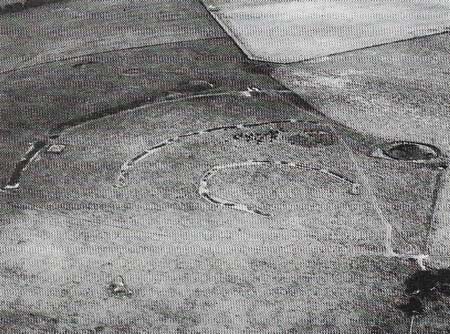
Burial in barrows was common in the late Stone and Bronze ages. The Neolithic people practised collective burial in monumental tombs with wooden or stone chambers under long or round mounds. Single burial under a round mound began at the end of the Neolithic period. This rite continued through the Bronze Age and cemeteries of these barrows, such as these at Windmill Hill, Wiltshire, are common in many parts of Britain. The practice of single burial, accompanied by grave goods, including some made of exotic and rare materials, suggests a changing emphasis in society, with stress now on the importance of the individual.
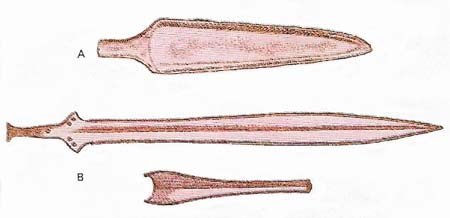
More efficient tools and weapons were developed during the Bronze Age. In the Early Bronze Age the chief personal weapon was the dagger (A) which lengthened into the full-length sword used for thrusting in the Middle Bronze Age. It was replaced by a slashing sword with a strong hilt and leaf-shaped blade, (shown with a chape from its scabbard) only in the Late Bronze Age (B).
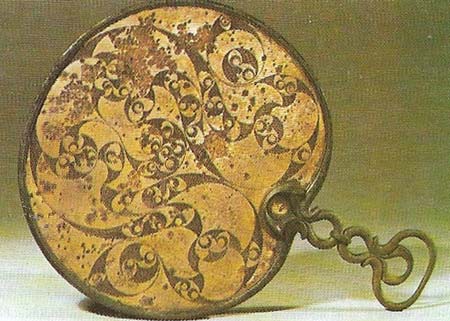
Decorated bronze mirrors are among the finest products of British craftsmen in the Early Iron Age and they must have been highly prized by their aristocratic women owners, with whom they were sometimes buried. This example, dating from the early 1st century AD, was found at Desborough, Northamptonshire. Its reflecting surface was made of polished bronze and its back was decorated with intricate patterns. The engraved area was probably set out with a pair of compasses; the outline was then engraved and the filling of parts of the pattern completed by chasing. Wear on the inside of the ring on the handle suggests that the mirror was suspended when it was not being used.
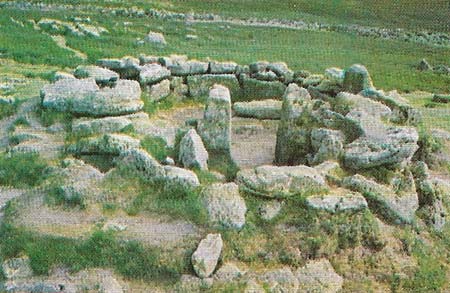
Dartmoor was an attractive area for prehistoric settlement and because it has been little exploited since early times it has many sites available for archaeological exploration. Stone was readily available there for use as a building material, and so the footings of walls of huts and of enclosures are still visible, as in this example at Grimspound. Few sites have yielded clear dating evidence but most were probably built in the Bronze Age. The huts are circular and vary in diameter from 3 meters (10 feet) to 12 meters (39 feet). Only the footings were of stone; the rest of the structure was timber, thatch and turf. The buildings were conical in shape.
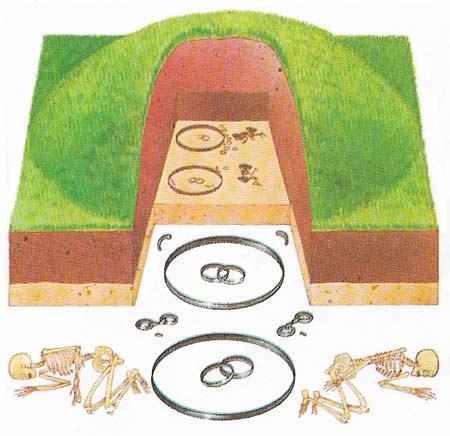
Chariot burials have been found of some of the warrior aristocrats of the Iron Age in Yorkshire. In this example from Danes' graves, two bodies were buried in a crouched position on the floor of a rectangular grave pit under a round barrow. With them were the remains of a dismantled chariot and several items of harness fittings. In other burials the chariot was buried intact and on one occasion two horses had been buried with the vehicle. This special type of burial does not occur elsewhere in Britain but is well known in continental Europe. It may have been introduced by settlers from Burgundy, where there are close parallels with the Yorkshire burials.
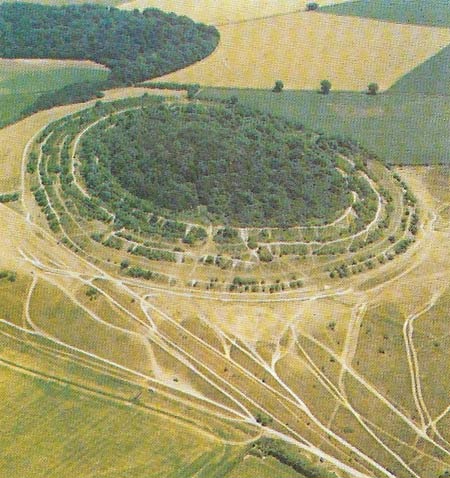
Hill-forts, or fortified settlements on hilltops, were first used in the later part of the Bronze Age, but most of them belong to the Iron Age. This example, Badbury Rings, Dorset, had a long development and may have lasted into the Roman period. The area enclosed is c. 7 hectares (17 acres), and is surrounded by two substantial banks and ditches, as well as a third, much slighter one outside them. One of the entrances turns inwards and the other has additional outworks. Hill-forts that have been excavated have revealed continuous intensive occupation, organised internal planning and some public buildings and provision for craftsmen. These hill-forts can be considered the first true urban settlements in Britain.
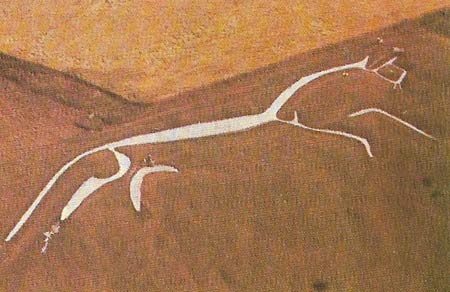
This large chalk-cut horse is situated just northwest of the hill-fort of Uffington Castle, Oxfordshire. It measures 110 meters (132 feet) in height and has been cut down to natural chalk in broad terraces. Such hill figures are impossible to date accurately, but on stylistic grounds this horse is usually thought to have been cut in the late pre-Roman Iron Age, and to have been the first hill figure in Britain. But some scholars give it a much later date. It is dramatically curved and attenuated form resembles horses portrayed by Iron Age craftsmen in other media, such as those found on coin or on wooden buckets decorated in sheet bronze, known from Aylesford and Marlborough. It may have been the symbol of a local tribe.
The end of the Neolithic period in Britain in the second half of the third millennium BC, was marked by major social and technological innovations. Collective burial under long barrows was replaced by a single burial under round ones; the first metal artefacts, of pure copper or a copper-arsenic alloy, are found in the burials; and a new type of pottery, known as the Bell Beaker, is found in burials and settlements throughout Britain. Traditionally these burials have been interpreted as marking the arrival of the so-called "Beaker people", metal prospectors from Europe. It is now thought, however, that the changes demonstrate internal developments in society rather than the arrival of a new people. The Beaker and copper dagger, already in use in Europe, were prestige objects for display by the increasingly important chiefs.
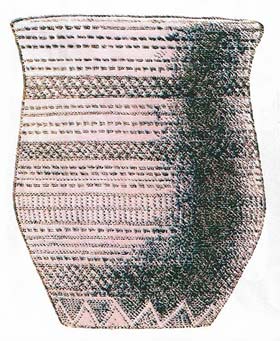 |
| Bell Beakers were a distinctive type of pottery introduced into England in the late 3rd millennium BC and buried as prestige objects with chieftains. These pots were drinking vessels made in a fine hard ware with a burnished surface, varying in color from red to dark brown or black. Their ornament was impressed in horizontal zones. Bell Beaker pottery has been found widely distributed in central and western Europe, and is especially common in parts of Spain and Portugal, southern France and Brittany, Czechoslovakia, Germany and the Low Countries. This distribution may reflect the movement of people prospecting for and trading in metal ores.
|
The Wessex culture
The Beaker period is sometimes described as the Copper Age, because of the predominance of copper tools at that time. In the full Early Bronze Age that began in the first half of the second millennium BC, the most notable feature was the emergence of the so-called Wessex culture in southern England. This was characterized by single burials under round barrows of specialized forms. The rich grave goods that accompanied the burials included objects of gold, amber shale and faience as well as the more usual bronze, flint, bone and pottery.
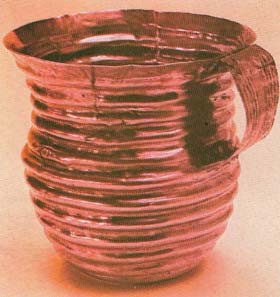 |
| This gold cup, found at Rillaton, Cornwall, is the best-known of the many goods of rich and rare materials that have been found in the round barrows of southern Britain, left in the graves of the wealthy aristocrats of the first half of the 2nd millennium BC. Amber and faience (a blue or turquoise vitreous paste made from a mixture of sand and clay) have also been found. This cup has been compared with vessels in the contemporary Shaft Graves at Mycenae, as have other gold and faience objects from the barrows of the Wessex culture. But these objects could have been made in Britain without the benefit of Mycenaean example. There is no other evidence for strong Mycenaean influence in Britain.
|
The chieftains of that time, now perhaps united under a "paramount chief" holding sway under a larger area, may have been responsible for the last main period of construction at Stonehenge with its massive sarsen stones (it may possibly have been built earlier, in Beaker times). There is continuing controversy whether the Wessex culture was introduced to Britain by intrusive overlords or whether it arose locally, and also whether there was contact between the Wessex culture and Mycenaean Greece.
The end of the Early Bronze Age, c. 1400 BC, saw a hiatus in sepulchral and religious development and a notable geographical shift in the centers of wealth. Wessex and southwest Wales ceased to be as rich as before and new centers of wealth arose in North Wales, the Thames Valley and the Fens. At the same time the old sky-oriented religion that had continued throughout the Early Bronze Age (as continuing activity at Stonehenge demonstrates) seems to have died out. In its place there is evidence, from the Middle Bronze Age onwards, of a new water-dominated religion; fine metalwork was put in rivers, lakes and bogs, presumable as offerings to water gods.
The later Bronze Age
Few rich burials have been found from the Middle and Late Bronze Ages; the normal rite was now cremation, often with an urn but without grave goods, under a barrow or in a flat cemetery. However, many hoards of metalwork date from that time. These demonstrate an increasing quantity of bronze in circulation and the growing mastery of metalworking techniques achieved by the bronzesmiths. They also indicate the development of new forms of tools and weapons; palstaves, rapiers and sickles, for instance, appear in the Middle Bronze Age. Whereas in the Late Bronze Age hoards, after c. 1000 BC, there are socketed axes, true swords and beaten metal objects, including shields and vessels. From the Middle Bronze Age onwards settlements are known; these include embanked enclosures and after c. 1200 BC the defended hilltop settlements known as hill-forts.
The first use of iron
The introduction of iron technology was not a sudden event. Some iron objects were occasionally used as early as c. 700 BC, but iron did not come into general use for another 200 years. The main factor in the development of the Iron Age was the continuing culture of the Bronze Age. The principal types of settlements – farmsteads, villages and hill-forts – all developed from Bronze Age antecedents, as did the round post-built house, which is one of the main Iron Age dwelling forms. However, there was certainly trade with Europe and, later in the Iron Age, there were also two limited movements of people from continental Europe. The first was a migration from France that brought the practice of chariot burials into Yorkshire perhaps as early as the late 5th century BC. The second was a movement from northeast France into southeast England in the first century BC. This can be identified by a historically known people, the Belgae, who were described by Julius Caesar (c. 100–44 BC).
Insular Iron Age communities were gradually developing an urban way of life during the second half of the first millennium BC, but the Belgae introduced a more organised urbanism already developed in Europe. They lived in large defended settlements known as oppida, which can be regarded as true towns; they were organised on a tribal basis and society was highly stratified, with a wealthy aristocracy at the top and slaves at the bottom, separated by a "middle class" of craftsmen and by the bulk of the peasantry who were engaged in primary production. They used the potter's wheel and they minted coins, both skills previously unknown in Britain. They traded abundantly with their Romanized relatives in Gaul and were partly Romanized by the time of the Claudian invasion of AD 43.
